multidimensionality
imperfection
instability
fluidity
In a world where technology redefines our perception of selfhood, identity becomes fluid, fragmented, and constantly evolving. My project, infiniteartist, is a multi-channel simulation that delves into this complexity by exploring alternative versions of identity through digital tools such as algorithms, AI, and generative processes.
infiniteartist embraces a multi-faceted approach, transcending the confines of a single medium or form. It combines performance, video performance, animation, and video to create a dynamic and integrative body of work. These diverse methods are not merely functional; they also serve as tools for delving into and reimagining the fluidity of identity in alternative forms. Through this exploration, I seek to capture the ongoing, boundless evolution and representation of my own identity, highlighting its complexity and multiplicity, while also acknowledging its instability, impermanence, and transformation.
Post-face and Fluidity of Identity
infiniteartist expands the term post-face, coined by Anna Szyjkowska-Piotrowska in her book Po-twarz. Przekraczanie widzenia w sztuce i technologii (Post-face. Transcending Vision in Art and Technology). Which plays a crucial role in understanding contemporary shifts in how identity and the face are perceived in art. The paradigm of the face, in its modern, proto-ethical version, still reaches for axiological concepts but is based on symbolic oppositional poles — emotions and affect, identity and subjectivity, all becoming unstable, fluid, and oscillating between self-affirmation and self-loss. This fluidity and uncertainty define the modern face paradigm, shaping it within the context of art. Contemporary artists, following these theories, blur the dichotomy of concepts such as interior/exterior, soul/body, human/animal, and feminine/masculine. The face, no longer just a face but a post-face, continues its presence in the realm of visual representation, undergoing dynamic transformations in the way it is depicted. It becomes a particular medium — a screen, carrying complex, often contradictory messages.
Szyjkowska-Piotrowska emphasizes that we no longer deal with a face in the traditional sense but with a post-face. It is a face in motion, subject to profanation, stripped of its sacred aura. The concept of post-face forces us to experience the sublime anew, revealing the uncertainty of identity and its constant transformation. The face transformed into a mask causes the disappearance of the traditional symbol of a fixed, singular identity, leading to its fluidity and instability, which in the modern paradigm, for many artists, takes the form of the post-face. This process is based on symbolic oppositional poles, questioning fundamental concepts of European humanism — identity, and unity.
Redefining the Traditional Face in The Digital Age
In the digital and media age, where the image of the face is often manipulated, processed, or even completely altered through digital technology. Unlike the traditional perception of the face as a carrier of identity and emotional expression, the concept of the post-face reveals the issue of the cultural and social construction of facial imagery, which can be shaped, modified, and distributed in various ways in the media space. The post-face becomes a tool for producing a subject, by annexing elements of identity, often utilizing already existing motifs in culture, symbols, and aesthetic paradigms. This practice involves the repetition of stereotypes, roles, and symbolic elements associated with visual culture. Contemporary art, characterized by the ubiquity of images and their ease of reproduction, enters a phase of a crisis of representation. The boundaries between reality and its digital representations are increasingly fluid, which, in turn, leads to the liquefaction of both identity and the medium itself.
AI, as the next stage of the post-face, becomes a significant element in this process. It represents a technological evolution that allows for the generation of faces on demand, thus leading to the extreme virtualization of images. The emergence of artificially generated faces disrupts the balance between the biological and digital realms, changing the way we perceive the boundaries between dichotomies. As a result, we witness a new definition of identity, where the lines between the human and the non-human become increasingly blurred, and the post-face serves as a tool for expressing this ongoing transformation.
Generating Multiple Identities
Modern technologies and the increasingly radical virtualization of art create space for more sophisticated tools and opportunities to express complex and/or simulated identities. In the context of new media art, the multivoiced and multi-imaged nature of identity gains a clearer representation. Images no longer limit themselves to the simple reproduction of reality; on the contrary, they can transform or distort it, distancing us from its original essence. This uncertainty, or even ambiguity of images, has always evoked unease. There is also the possibility that images conceal an absence—a lack of something that has passed, disappeared, or perhaps never existed. Instead of reflecting reality, an image can replace or displace it, surpassing the boundaries of categorization as true or false. As a result, it becomes more real than reality itself, transitioning into the realm of simulation.
I broke down my identity, cataloged it, and then multiplied it. At the beginning, there was a database. A collection created from my thoughts and AI suggestions, divided into environments, art movements, media, nightmares, decisions, and health issues. From this, models were generated, further equipped with random levels of ego, condition, and susceptibility to external influences, as well as the degree of attitude toward academia, the world, and the art market. Next, they were cataloged with an individual number.
Based on their traits, the AI-generated a verbal description of the image, which was then illustrated by an algorithm that created an image using my likeness as a reference point. Another algorithm brought them to life and allowed them to move and speak with my cloned voice. They narrate their characteristics, which were written by the AI.
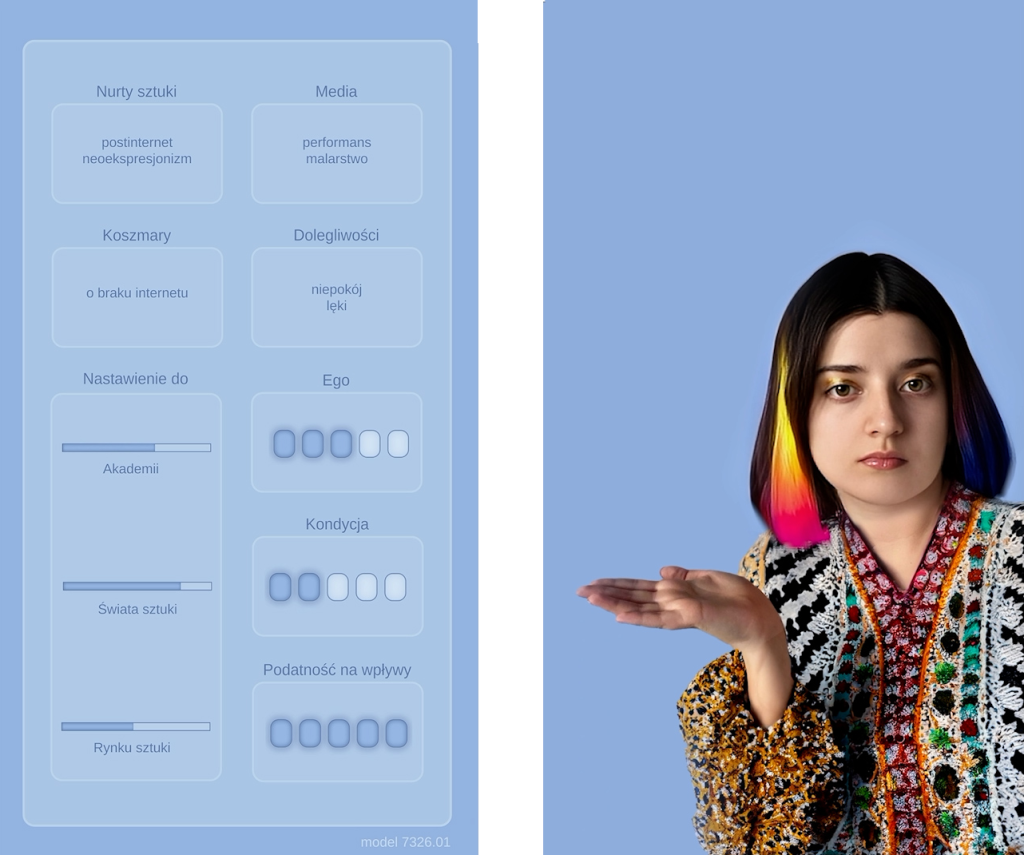
The embodiment of specific traits with a given appearance reveals the physiognomic interpretation followed by AI. This way of perceiving is the result of analyzing visual data and machine learning algorithms, which attempt to assign specific internal meanings or values to particular external symptoms and signs, thus returning to the face as an icon. However, the focus on the aesthetic aspects of the face strips it of its privileged, metaphysical character. Making the algorithms, controlled and selected by humans, tools for creating new masks.
The presentation of multiple versions serves to articulate a fragmented and simulated identity. The infinitemodels represent alternative possibilities or paths that could have been or are still available, reflecting the constantly changing nature of identity. The fact that the models contain imperfections and flaws reflects the human condition—they do not represent an ideal or a singular form, but rather reveal the uncertainty and disorientation of the individual in today’s world, where identity is often defined by media representation and cultural consumption. In this context, the artist becomes an unstable product, subject to market and media pressure—this can lead to a loss of authenticity and personal integrity, encouraging the adoption of multiple masks.
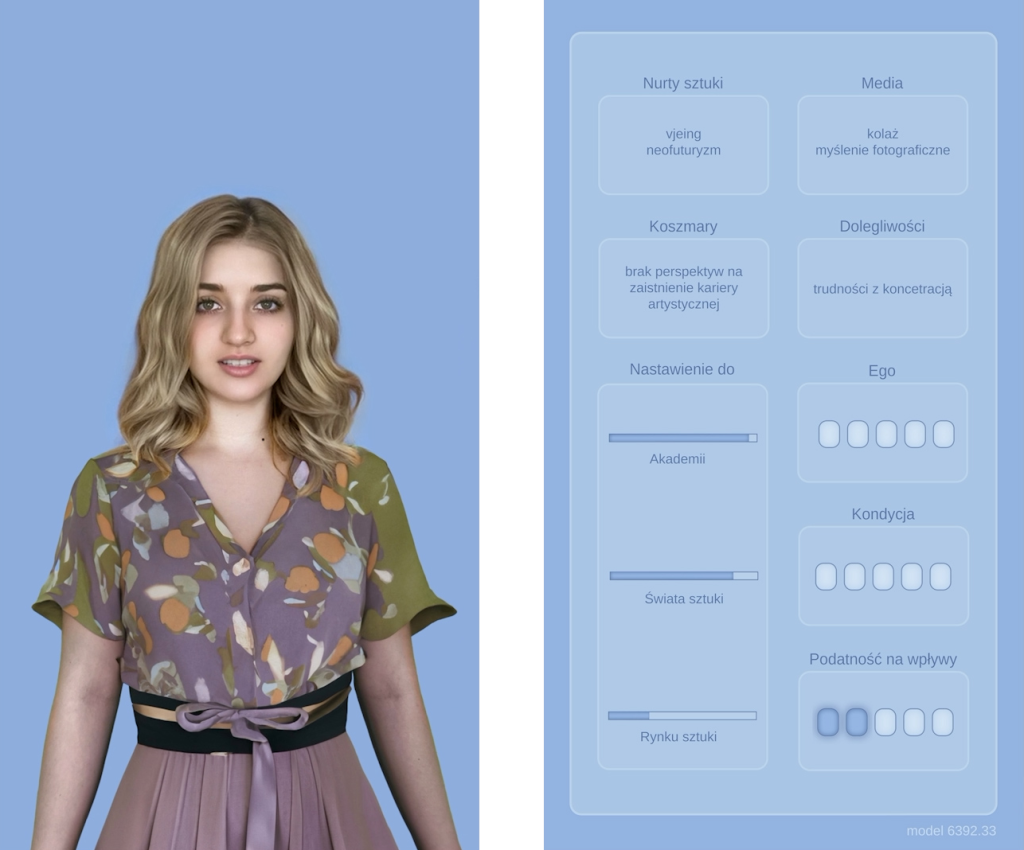
These models are not valued in any way, meaning they are neither judged nor hierarchized in terms of their importance or quality; each is treated as equal to the others. The work focuses on the hybrid construct of identity—it operates within a symbolic system where the image and female identity receive a completely different representation, reflecting a more complex and multi-dimensional experience of existence that serves as a space for diverse narratives and perspectives.
The image, understood as a representation, transcends individuality in an attempt to reveal more general and symbolic layers — the presented work creates a symbiotic connection between technology and human expression — an artificiality and unnaturalness are palpable, emphasizing that, even today, there remains a boundary between the human and the non-human, while simultaneously provoking reflection on the impact of modern technologies on the future perception of identity. They are grotesque and unsettling, and some of them I can barely look at. They remind me of talking heads from TikTok, they remind me of myself. They are everything I can be and everything I cannot be. They are made by me, yet at the same time, I have nothing to do with them.
Algorithmic Identity
The blurring of dichotomy is revealed in the work actualmodel, which refers to aspirations to transform human identity into a database controlled by algorithms. The current identity is randomly selected from the data set, becoming a tool for the creation and refinement of the subject through the annexation of elements and paradigms from the digital world of life simulators. The work illustrates the continuous transformations of models, showcasing the current status, detached from my physical form. This dynamic relates to the process of cataloging and exposing inner values that are presented outwardly.
In this sense, the concept of actualmodel echoes the notion of the face-icon found in metaphysical thought and physiognomic interpretation. Here, external symptoms and signs serve as tools for inferring what is hidden, ineffable, and elusive. Just as the classical approach to the face in the tradition of portrait painting assumes the possibility of expressing the inner self through external features, actualmodel explores how identity—rooted in internal qualities—is externalized, shaped, and displayed, albeit through the mechanisms of the digital and algorithmic world.
In the context of a modern society where individuals are increasingly perceived as products, this approach refers to mechanisms in which people are compelled to display and promote their traits to attract attention and gain social acceptance. Identity is often not only revealed externally but also simulated to fit into desired frameworks. Like the classical portrait, which seeks to convey the inner through the outer, actualmodel underscores the interplay between internal substance and external representation, albeit through the lens of digital transformation and simulation.
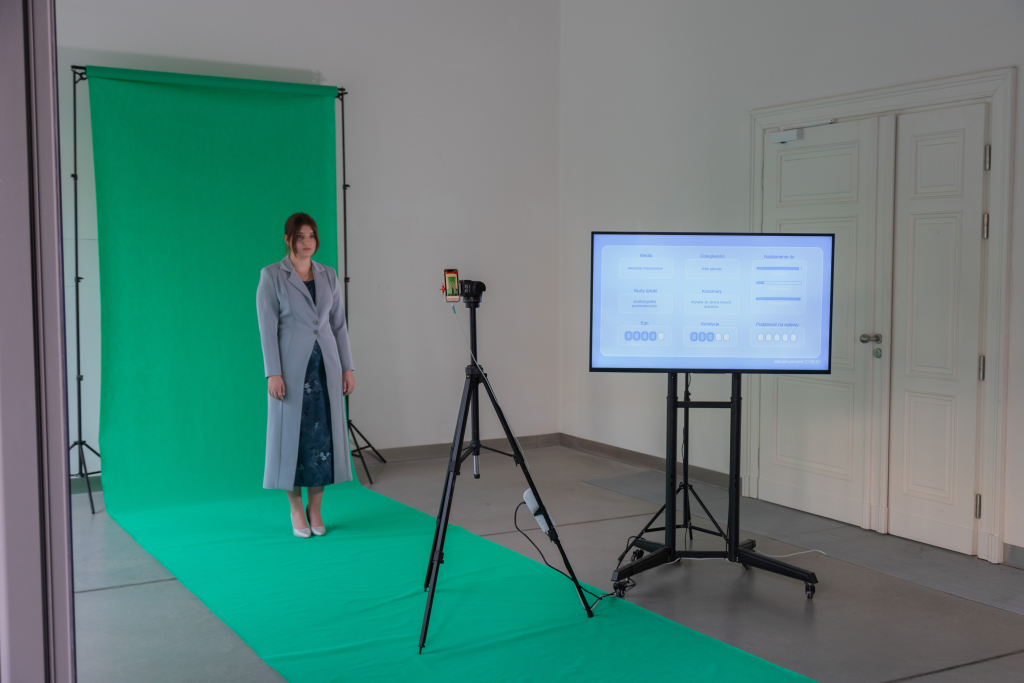
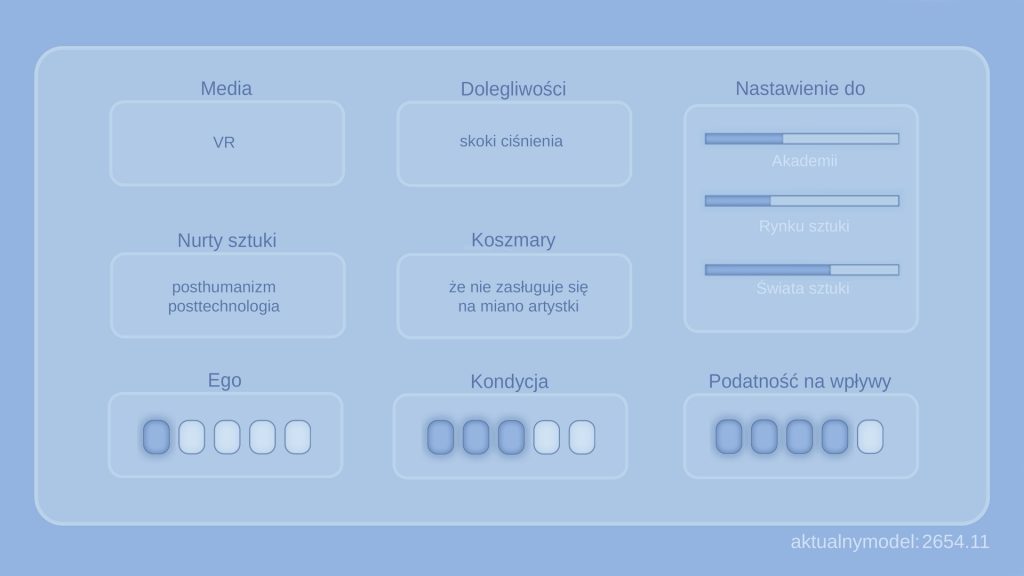
These issues are explored in the video performance panelsofmodelselection, which delves into the construction of identity through the presentation of various interactions influencing identity formation. In the video, I am dressed in attire matching the animation’s color palette, surrounded by six panels, each presenting different decisions and aspects of identity-building within the artistic world. The work appropriates the interaction selection mechanism from the life simulation game The Sims 2. By incorporating this dynamic into the performance I draw a parallel between creating and altering identities within a virtual space and the process of constructing identity in the real world.
In The Sims 2, all actions are predefined by the game’s programming, and similarly, in real life, the “choices” individuals face are often shaped by societal structures, expectations, and technological interfaces. By appropriating this mechanic, the artwork blurs the boundary between digital and real-world identity construction, questioning to what extent our “authentic” selves are products of external systems and frameworks. The digital world of life simulators, originally modeled after real life, now loop back to influence it, blurring the boundaries between the two realms.
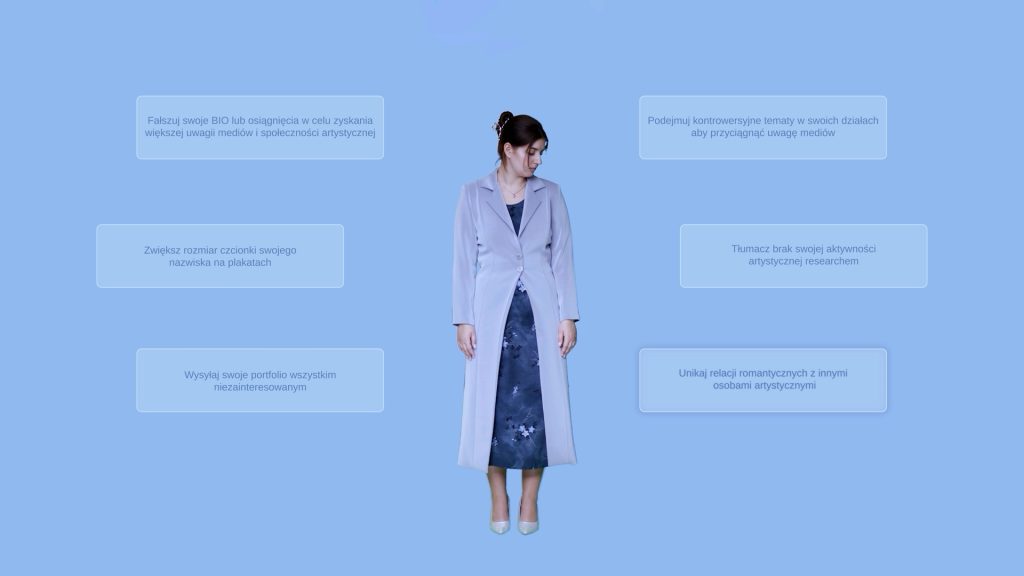
The final component of the artistic project is the modelenvironment, which represents a deeper engagement between the real image and the virtual world governed by algorithms. This performance utilizes the process of live keying, where my physical presence is captured in real time and then transferred into virtual environments generated entirely by an algorithm. During the exhibition, I physically stood in front of a green screen, and my image was streamed live onto the gallery space, merging my real-world presence with AI-generated environments. The live feed became a bridge between these two realms, allowing the audience to witness a real-time transformation of my body and image into a fully digital context. This dynamic process blurred the lines between what was physically present in the gallery and what was algorithmically created, challenging the traditional expectations of performance art.
By wearing the same outfit as in the panelsofmodelselection, I achieved an effect of physical/digital multiplicity, where the simultaneous presence of my physical form and two digital counterparts—one from the video and one generated live—obscured the reality of the performance. At first, the audience didn’t realize that one of the representations was a live projection, and later they struggled to distinguish which was the pre-recorded video and which was the live projection.
Instead of simply mirroring reality, the performance sought to transform and distort it, removing it from its original context and redefining the terms of authenticity. By transcending the binary of true and false, the act of transformation became a simulation of reality. Through this performance, I engage with the idea of identity as something malleable and shifting, especially in the context of contemporary digital culture. The performance questions how much of our identity is truly “real,” and to what extent it is shaped or even constructed through external systems, such as algorithms and digital media. Ultimately, the modelenvironment demonstrates the complex relationship between physical and virtual selves, offering a space where the boundaries between reality and simulation are no longer clear-cut but are in a constant state of negotiation.

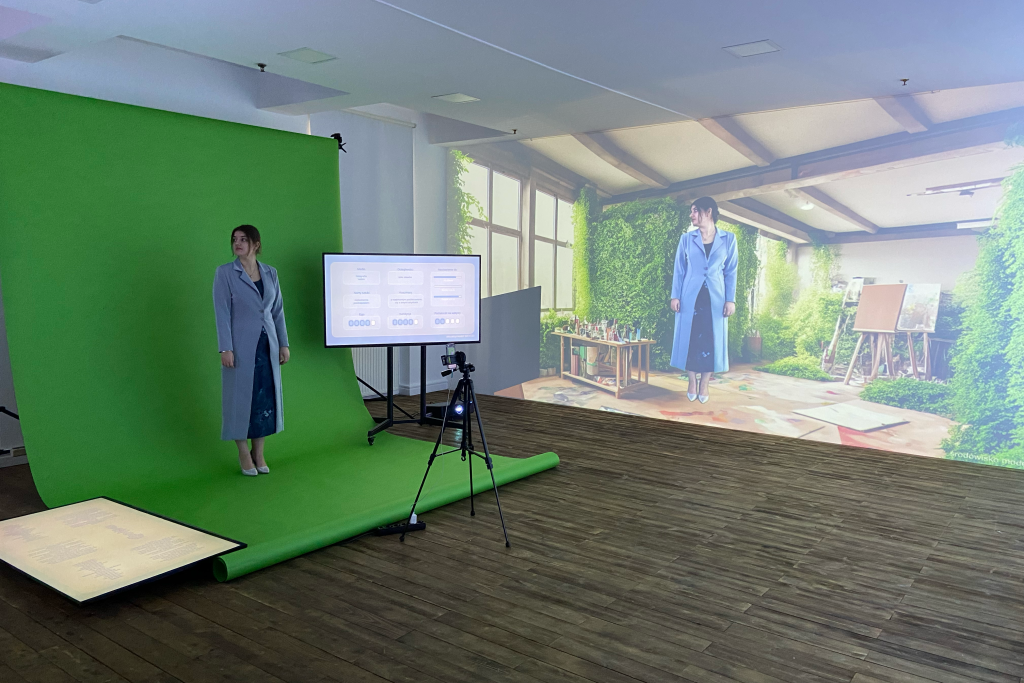
Self
Using my own image has been a long-standing practice in my work, where I’ve consistently employed my likeness as a tool of expression. The act of presenting my face and body is not simply about performing an identity or creating an avatar; it’s about grounding the work in the lived, embodied self. A virtual persona lacks the inherent human experience that my identity carries—because, to have a true post-face, one must first have a face.
The artist’s face and body, as a result of tensions and the transformative power of art, have become an ongoing and essential reflection in the context of contemporary Western European culture. The artist’s physiognomy, in this sense, acts as a symbolic field where the dynamic interaction between art and society unfolds. This exploration is deeply tied to understanding how the artist’s face and body serve as artistic tools, as well as the implications of this in the creation of artworks.
By using my face and body, I am making a statement about the power of lived experience in the creation of art. My work isn’t simply about visual representation; it’s about the continuous transformation of my dentity through art, and ultimately, this process is about me. It’s rooted in my practice and my reflection on how we, as individuals, navigate and negotiate our identities in a world shaped by both traditional and digital forces.

